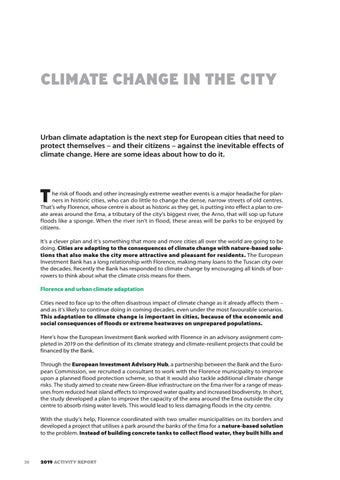CLIMATE CHANGE IN THE CITY
Urban climate adaptation is the next step for European cities that need to protect themselves – and their citizens – against the inevitable effects of climate change. Here are some ideas about how to do it.
T
he risk of floods and other increasingly extreme weather events is a major headache for planners in historic cities, who can do little to change the dense, narrow streets of old centres. That’s why Florence, whose centre is about as historic as they get, is putting into effect a plan to create areas around the Ema, a tributary of the city’s biggest river, the Arno, that will sop up future floods like a sponge. When the river isn’t in flood, these areas will be parks to be enjoyed by citizens. It’s a clever plan and it’s something that more and more cities all over the world are going to be doing. Cities are adapting to the consequences of climate change with nature-based solutions that also make the city more attractive and pleasant for residents. The European Investment Bank has a long relationship with Florence, making many loans to the Tuscan city over the decades. Recently the Bank has responded to climate change by encouraging all kinds of borrowers to think about what the climate crisis means for them. Florence and urban climate adaptation Cities need to face up to the often disastrous impact of climate change as it already affects them – and as it’s likely to continue doing in coming decades, even under the most favourable scenarios. This adaptation to climate change is important in cities, because of the economic and social consequences of floods or extreme heatwaves on unprepared populations. Here’s how the European Investment Bank worked with Florence in an advisory assignment completed in 2019 on the definition of its climate strategy and climate-resilient projects that could be financed by the Bank. Through the European Investment Advisory Hub, a partnership between the Bank and the European Commission, we recruited a consultant to work with the Florence municipality to improve upon a planned flood protection scheme, so that it would also tackle additional climate change risks. The study aimed to create new Green-Blue infrastructure on the Ema river for a range of measures from reduced heat island effects to improved water quality and increased biodiversity. In short, the study developed a plan to improve the capacity of the area around the Ema outside the city centre to absorb rising water levels. This would lead to less damaging floods in the city centre. With the study’s help, Florence coordinated with two smaller municipalities on its borders and developed a project that utilises a park around the banks of the Ema for a nature-based solution to the problem. Instead of building concrete tanks to collect flood water, they built hills and
30
2019 ACTIVITY REPORT




